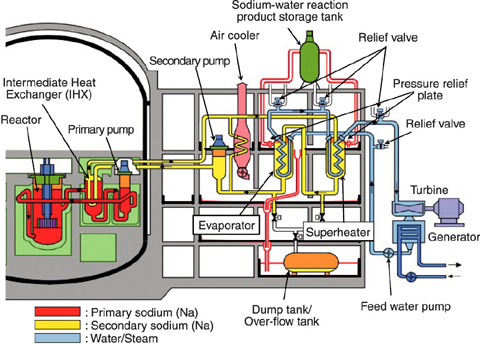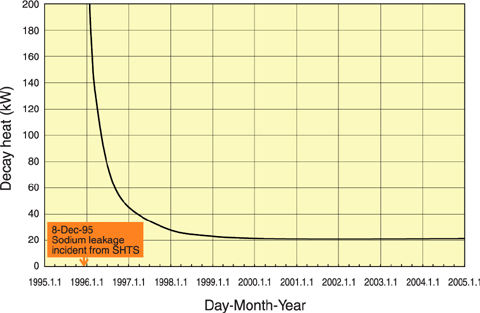
Fig.12-1 Overview of "MONJU"

Fig.12-2 The change of decay heat after sodium leakage
The main heat transport system of "MONJU" is divided into three systems: the primary heat transport system (PHTS) to extract heat from the reactor core, SHTS to transmit heat of PHTS to the steam-water system and the steam-water system to turn a turbine-generator. They are composed of three loops. Fig.12-1 is an overview of " MONJU".
The modification work for restartup started in March 2005. The main content of the modification work is as follows.
1. Change or removal of thermocouple wells in SHTS
2. Improvement of sodium leak countermeasures
3. Improvement of steam generator (SG) safety
Before the above-mentioned modification work was started, shortening the modification period was discussed. In the discussion, PHTS one-loop operation (All of sodium in the SHTS was drained and one-loop of the PHTS was circulated) was discussed.
Two conditions to change to PHTS one-loop operation are as follows. First, the heat loss must exceed the reactor core decay heat. Secondly, it is possible to make the difference between the heat loss and the decay heat smaller than the capacity of preheater, which is to keep the temperature of the in-vessel sodium at 200°C.
Concerning the first condition, the estimated heat loss in the primary system was in the range of 110-160 kW in one-loop operation, and the calculated decay heat was 21.2 kW (Fig.12-2). Although the heat input of the primary pump was considered, it was clear that circuit heat loss greatly exceeded the decay heat. The FPGS90 analytic code was used for the evaluation of the decay heat, because there is no means to measure it directly when the system is cold on standby. The heat loss was calculated by the HVAC method. The HVAC method calculates the heat loss from each piece of equipment and pipe by calculating the total heat loss of all equipment and the pipes in the targeted room from the temperature fluctuation of heat exchanger inlet-outlet in RV nitrogen atmosphere air-conditioning system and distributing the heat loss according to ratios derived from the design.
Concerning the second condition, because the normal set value of the preheater can not keep the in-vessel sodium at about 200°C, the set value of the primary preheater was changed and the heat loss of one-loop operation of PHTS was reduced.
One-loop operation of PHTS was able to be executed by means of these measures. It brings about not only shortening of the construction period but also reduction of the electrical consumption within the power plant.
<Previous: 12 Development of Experimental Techniques / Facilities at JAEA R&D Centers | Next: 12-2 >